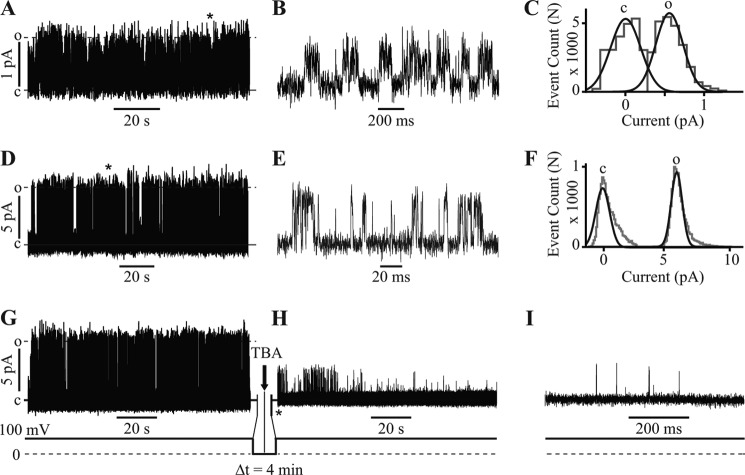FIGURE 4.
KvLm PM is functional as crystallized and conserves structural features of the eukaryotic PM. A, reconstitution of KvLm PM in monoolein lipid bilayers. B, single-channel currents recorded at 150 mV in 27 mm KCl. The section marked by the asterisk in A is displayed in B at a 100-fold higher time resolution; γ = 4 ± 2 pS. C, all event current amplitude histogram of a 6-min-long recording in symmetric 27 mm KCl, 10 mm Hepes, pH 7.4, at 150 mV. The total number of opening events (N) analyzed was 34,225; γ = 4 ± 2 pS. γ was calculated from Gaussian fits (black lines) to current amplitude histograms (gray lines); c and o denote closed and open states. D, currents at 100 mV in 0.5 m KCl. E, the section marked by the asterisk in D is displayed in E at a 1000-fold higher time resolution; γ = 68 ± 9 pS. F, all event current amplitude histogram of a 5-min-long recording in symmetric 0.5 m KCl, 10 mm Hepes, pH 7.4, at 100 mV. n = 20,200 and γ = 68 ± 9 pS. G, currents at 100 mV in 0.5 m KCl before addition of blocker. After 2 min at 0 mV, 100 μm tetrabutylammonium (TBA) was injected onto one side of the bilayer (arrow) followed by a 2-min waiting time at 0 mV. H, the voltage was stepped to 100 mV evoking the single-channel currents. I, the segment immediately succeeding the application of the second 100-mV step indicated by the asterisk in H, displayed at 100-fold higher time resolution, demonstrates that the channel is already blocked at the onset of the voltage step. Δt signifies the time interval at 0 mV.

